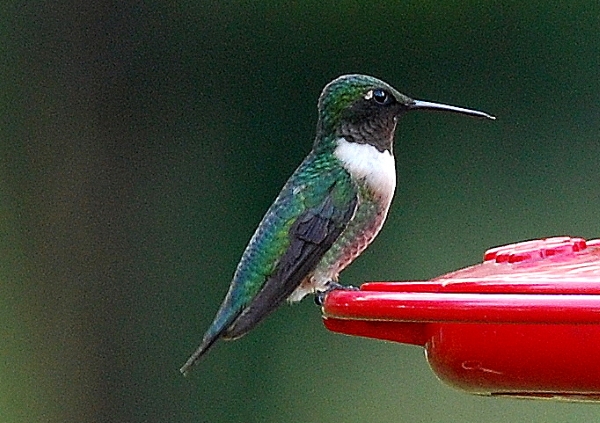
By Terry W. Johnson
Summer is the best time of year for Georgia hummingbird watchers. During the sultry days of summer Georgians play host to more hummingbirds than at any other time. Some days, more than 100 hummingbirds will visit a single backyard in search of nectar produced by flowers and the sugar water offered in feeders.
At a distance, all of these birds can look the same. However, when you take the time to really study them, it quickly becomes apparent that there appears to be at least three different kinds of hummers vying for the opportunity to dine at your backyard hummingbird cafe. Later in the summer, it can become even more confusing when you might see an additional odd hummer or two.
The vast majority of these seemingly different birds are actually ruby-throated hummingbirds: They’re just adult males, females and juvenile males.
Although there are a number of subtle differences between these ruby-throat sex and age groups, here are a few simple tips that will enable you to easily tell them apart.
Adult males: The adult male ruby-throated hummingbird sports a ruby-red throat, or gorget. Since this gorget changes color depending on lighting conditions, identification of a male ruby-throated hummingbird is sometimes tricky.
In direct sunlight, the gorget will appear bright red. Yet the gorget transforms to charcoal black in the blink of an eye when a cloud slips in front of the sun (as shown in the photo). Once the cloud passes, the charcoal black color vanishes and the brilliant red hue reappears.
Juvenile males: During its first summer of life, the throat of a male ruby-throated hummingbird is pale and marked with a series of black dots arranged in lines emanating from the base of its bill.
As summer leisurely moves closer to fall, a few red gorget feathers appear. I have seen anywhere from one to 19 or more gorgeous ruby-hued feathers adorning the throats of young males before the birds disappear from my backyard by late summer.
Females: Adult and juvenile female ruby-throated hummingbirds have light-colored, unmarked throats. Consequently, it is next to impossible to tell a young female from an adult unless you hold it in your hand and carefully examine the bill. The bills of all young hummers appear to have wrinkles; whereas, the bills of adult female and male hummingbirds are smooth.
Rufous Hummingbirds
The rufous hummingbird is the most common hummingbird seen in Georgia during the winter. These long-distance migrants nest from the Pacific Northwest all the way to southeastern Alaska.
While most rufous hummers winter in Mexico, each year thousands of them winter in the Southeast. Although most of these wintering birds arrive in late fall and early winter, some show up in Georgia during the summer.
The adult male rufous hummingbird looks like it has been dipped in cinnamon. The bird’s gorget is orange-red; its back, sides and tail are reddish brown. It is next to impossible to misidentify an adult male rufous hummer.
Females look much like female ruby-throats. However, if a bird has at least one brown feather on its green back and it displays some brown on its tail, it is a rufous.
Juvenile male rufous hummingbirds resemble females. Like immature ruby-throats, though, their throats will be accented with lines of dark dots and varying numbers of gorget feathers. These feathers are orange-red as opposed to the ruby-red on young male ruby-throats.
Green Violetear Hummingbirds
This species is extremely rare in Georgia. While it has been reportedly seen in the Peach State a handful a few times, the Georgia Ornithological Society, the organization that maintains the official records of Georgia birds, lists only one accepted record for this species – a bird spotted in Thomasville in the summer of 2001 (July 8, to be exact).
However, because the bird was never photographed or captured, it is not listed on the official list of birds documented in Georgia. Until a sighting has been fully documented, it remains on the Georgia Ornithological Society’s provisional species list.
The green violetear is a large hummingbird that lives in the mountainous forest regions of Mexico and Central America. Yet, this avian wanderer has made sporadic visits to Texas and North Carolina, as well as north to Ontario and Alberta.
Males display a violet-blue "ear" and central breast spot. The bird has a golden to grass-green back and the top of its tail is blue-green. Females are duller versions of the male.
Watch your feeders closely this summer. Now that you know how to discern the various plumages displayed by ruby-throats, perhaps you will be able to identify an early rufous, or even an extremely rare visitor from Mexico or Central America such as the green violetear.
Now that would be highlight of any hummingbird watcher's summer!
In the meantime, I hope swarms of hummingbirds provide you with hours of enjoyment this summer.
Terry W. Johnson is a retired Nongame program manager with the Wildlife Resources Division and executive director of The Environmental Resources Network, or TERN, friends group of the division’s Nongame Conservation Section. (Permission is required to reprint this column.) Learn more about TERN, see previous “Out My Backdoor” columns, read Terry’s Backyard Wildlife Connection blog and check out his latest book, “A Journey of Discovery: Monroe County Outdoors.”




















